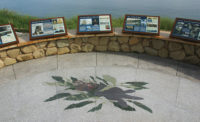The aim of the exhibition is to illustrate to the Swiss public the development, history and use of white marble over the centuries through specifically prepared illustrative materials.
With the assistance of university teachers and specialized companies from the sector, 24 large posters have been prepared to illustrate the geological aspects of the material (geological history, scientific classification, mapping) as well as the stone's technological and the economic aspects (quarrying, processing, use of waste). The exhibition also showcases the use of marble in design and architecture as well as the techniques of sculpture.
Courtesy of the Gallery of the Academy of Florence, a poster has been prepared on the just-finished restoration of Michelangelo's David, the most famous sculpture in the world, a veritable symbol of white marble.
The exhibition is completed by twelve marble slabs from the Apuan Alps of the best known and most widely used varieties of Carrara White marble (Bianco P, Bianco Ordinario, Bianco Venato, Statuario, Calacatta, Cremo, Nuvolato, Bardiglio, Arabescati, Cipollino), to allow visitors to appreciate the features of different varieties of white marble. There will also be a video on the restoration of the David as well as features on the Marble Museum in Carrara and IMM.
“We have been only too glad to seize such a great opportunity for promotion that allowed us to illustrate the history of our precious material and its applications in the most significant works,†said Giancarlo Tonini, President of IMM Carrara. “We are pleased to cooperate with so many experts in a valuable setting such as Zurich's Engineering School.â€
“Il Marmo nella storia†has been designed as a travelling exhibition, as the materials on display are provided with multilingual comments. It will be open in Zurich until September 30, and it will then be on display first in the premises of Internazionale Marmi e Macchine in Carrara, then in the Universities of Pisa and Parma.
